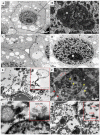Mitochondrial and Chromosomal Damage Induced by Oxidative Stress in Zn2+ Ions, ZnO-Bulk and ZnO-NPs treated Allium cepa roots
- PMID: 28120857
- PMCID: PMC5264391
- DOI: 10.1038/srep40685
Mitochondrial and Chromosomal Damage Induced by Oxidative Stress in Zn2+ Ions, ZnO-Bulk and ZnO-NPs treated Allium cepa roots
Abstract
Large-scale synthesis and release of nanomaterials in environment is a growing concern for human health and ecosystem. Therefore, we have investigated the cytotoxic and genotoxic potential of zinc oxide nanoparticles (ZnO-NPs), zinc oxide bulk (ZnO-Bulk), and zinc ions (Zn2+) in treated roots of Allium cepa, under hydroponic conditions. ZnO-NPs were characterized by UV-visible, XRD, FT-IR spectroscopy and TEM analyses. Bulbs of A. cepa exposed to ZnO-NPs (25.5 nm) for 12 h exhibited significant decrease (23 ± 8.7%) in % mitotic index and increase in chromosomal aberrations (18 ± 7.6%), in a dose-dependent manner. Transmission electron microcopy and FT-IR data suggested surface attachment, internalization and biomolecular intervention of ZnO-NPs in root cells, respectively. The levels of TBARS and antioxidant enzymes were found to be significantly greater in treated root cells vis-à-vis untreated control. Furthermore, dose-dependent increase in ROS production and alterations in ΔΨm were observed in treated roots. FT-IR analysis of root tissues demonstrated symmetric and asymmetric P=O stretching of >PO2- at 1240 cm-1 and stretching of C-O ribose at 1060 cm-1, suggestive of nuclear damage. Overall, the results elucidated A. cepa, as a good model for assessment of cytotoxicity and oxidative DNA damage with ZnO-NPs and Zn2+ in plants.
Figures







References
-
- Nakada T. et al.. Novel device structure for Cu (In,Ga) Se2 thin film solar cells using transparent conducting oxide back and front contacts. Solar Energy 77(6), 739–747 (2004).
-
- Gedamu D. et al.. Rapid fabrication technique for interpenetrated ZnO nanotetrapod networks for fast UV sensors. Adv. Mater. 26(10), 1541–1550 (2014). - PubMed
-
- Meulenkamp E. A. Synthesis and Growth of ZnO Nanoparticles J. Phys. Chem. B 102(29), 5566–5572 (1998).
-
- Lin D. & Xing B. Phytotoxicity of nanoparticles: inhibition of seed germination and root growth. Environ. Pollut. 150, 243–250 (2007). - PubMed
Publication types
MeSH terms
Substances
LinkOut - more resources
Full Text Sources
Other Literature Sources

